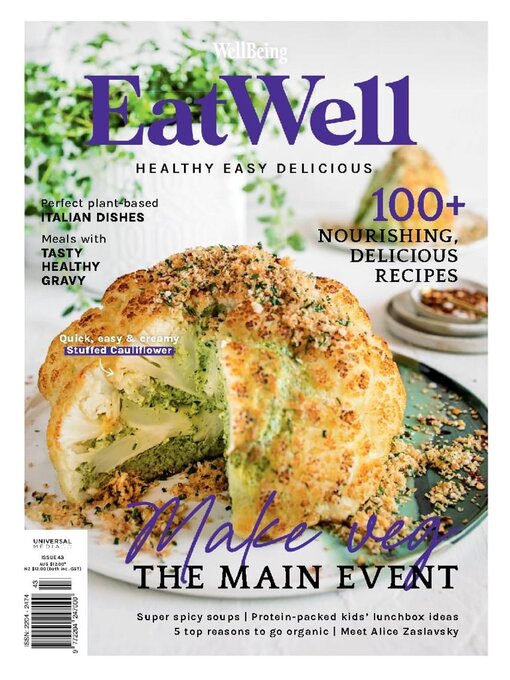A sexy Recipe Mag that has a healthy approach to good food. Taste every page as you flick through – delicious! Why bother? Because everything in here is good for you, easy, and yum. We know you are busy so we give you everything you need to eat well – recipes, shopping lists, quick ideas. You’re tapping in to a heap of wisdom from passionate chefs, bloggers and caring home cooks. You can share yours too – we’re a community. Life’s short…. outsource your food plan to people who love healthy good food. If you stopped buying recipe mags years ago because they’re full of things you can’t eat – then try Eat Well! Over 70 recipes per edition.
Swedes • Swedes are a hybrid resulting From cross- breeding a turnip and a cabbage. They were developed in the 1600s in Sweden but have found their way around the world. Swedes have a delicate flavour and can be eaten raw if fresh and very young. Older swedes can be mashed, stir-fried, roasted, steamed or baked. They also make a great addition to soups or stews because they absorb surrounding flavours so well. As a warm winter treat, swedes go really well when combined with butternut pumpkin or sweet potato, mashed with butter and topped off with nutmeg and black pepper.
Karjalanpiirakka • Karjalanpiirakka is a popular Finnish food that originated in the region of Karelia. It is made using a pastry that is a mixture of rye and spelt flours. The fillings were barley and talkkuna (a mixture of roasted barley, oats, rye and pea flour) however in the 1800s the mixture began to be played with and other ingredients were brought to the dish. Today karjalanpiirakka consists of the rye pastry crust filled with rice pudding and then topped with egg butter. It can be eaten as breakfast, as a snack, or as a perfect accompaniment to a spicy soup.
from the EDITOR
Eat Well
Our Chefs
Grog • Although “grog” has become a generic term for alcohol in modern Australia, it is in fact a specific drink that originated in north Germany during medieval times. In the 18th century, grog became a favoured drink on board ships of the English Royal Navy and today it is still popular in mountain skiing regions of Germany, Austria and Switzerland. Essentially, today grog is made with boiling water and then an alcoholic base of perhaps apple Cider or cognac. The water is added to the cider and then mixed with lemon juice, cloves and cinnamon. Some recipes also include sugar, but that is a matter of taste (and health).
Radish (Raphanus sativus) • Radishes are super easy to grow and have a delightful peppery flavour, making them a joy in your kitchen.
7 FOODS TO EAT EVERY DAY • Discover the top seven nourishing foods you should work into your diet on a daily basis.
SPICY SOUPS • It's a guess, but it is believed that the first soup was made around 20,000 years ago. This date is assumed because we think that as soon as humans made mud vessels or clay pots, they started boiling their food in water to make a delicious and simultaneously warming dish. Written evidence tells us that soups were being made at least 6000 years ago and that a variety of ingredients were being used. If you want to add to the warm temperature of a soup, there is nothing nicer than adding a little culinary spice, so here are some delicious spicy soup ideas including: creamy jalapeňo popper soup; Thai chicken and coconut soup; cauliflower soup with parmesan croutons; beef pho; chicken enchilada soup; Mexican corn soup; and mushroom and pepperberry soup.
EatWell with Emma
EatWell with Emma • BROUGHT TO LIFE BY Tilda products
Balsamic vinegar • Balsamic vinegar originated in Italy and is an aged reduction of white sweet grapes that are boiled to a syrup. Traditional preparation involves the grapes being cooked slowly in copper cauldrons until the water content is reduced by 50 per cent. The resulting...

 Issue 59
Issue 59
 Issue 58
Issue 58
 Issue 57
Issue 57
 Issue 56
Issue 56
 Issue 55
Issue 55
 Issue 54
Issue 54
 Issue 53
Issue 53
 Issue 52
Issue 52
 Issue 51
Issue 51
 Issue 50
Issue 50
 Issue 49
Issue 49
 Issue 48
Issue 48
 Issue 47
Issue 47
 Issue 46
Issue 46
 Issue #45 2022
Issue #45 2022
 Issue #44 2022
Issue #44 2022
 Issue #43 2022
Issue #43 2022
 Issue #42 2022
Issue #42 2022
 Issue #41 2022
Issue #41 2022
 Issue #40 2022
Issue #40 2022